Audiophile | Review On Behringer U-Phoria UMC-22 Audio Interface
hive-190212·@ophibious·
0.000 HBDAudiophile | Review On Behringer U-Phoria UMC-22 Audio Interface
Hello there, my BD Hivers. I hope you're all in good form and everything is in order. Today I'm back with a sound card/audio interface review. Audio instruments are something that we can use for the longest time, and I believe if used in the right way. If you're an audiophile, you already know how much we enjoy the fantastic sound and cherish its harmony. For most of us, good music is a blessing in disguise. And, to provide a better experience, we use higher-quality monitors, sound cards, cables, IEMs, equipment, and so on. **This review would be more over the top, talking about the general quality and real-life usage of Behringer UMC22 rather than a point of view from numbers.** 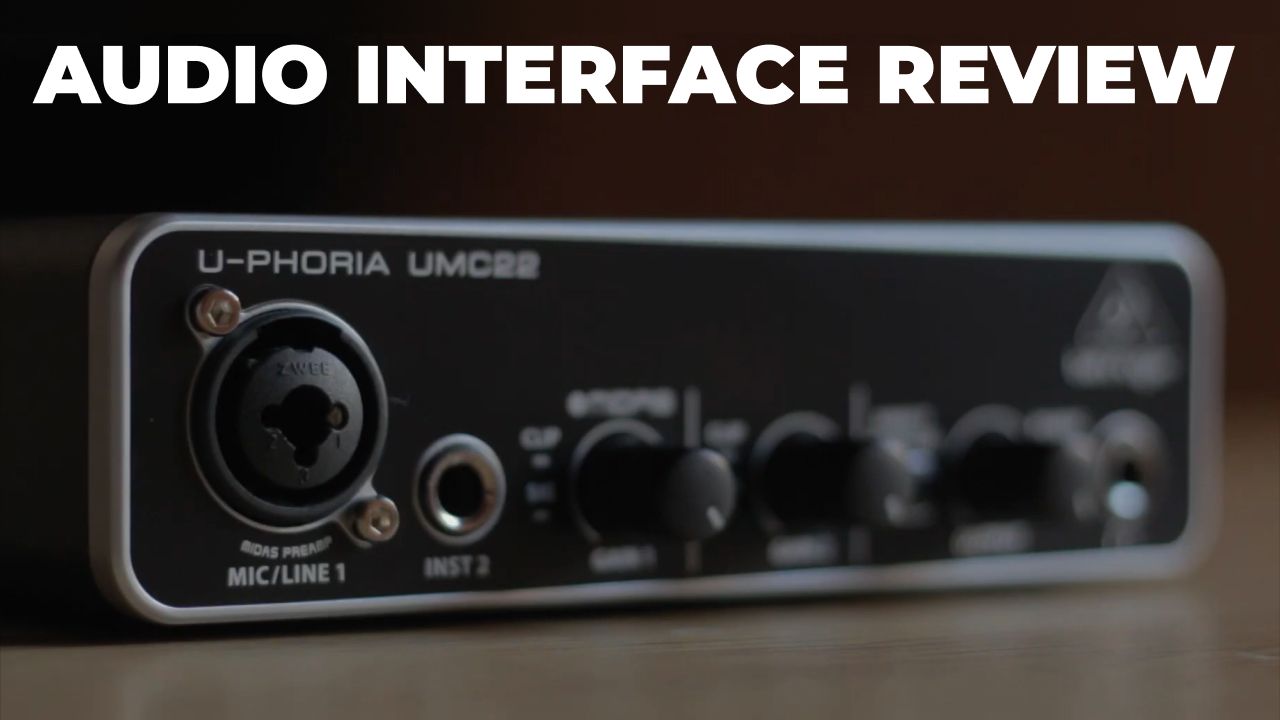 ## What is an Audio Interface? If you're into podcasting, streaming, or recording, you're already familiar with this instrument; you can skip this section. For my friend who is unfamiliar with audio interfaces, they transform microphone and instrument signals into a format that your computer and software can understand. Audio from your computer is also sent over the interface to your headphones and studio monitors. Interfaces often connect to your computer via USB connections, thunderbolts, firewire, or even ethernet is astounding. The cost of an audio interface can range from $50 to several thousand dollars. Even the most budget-friendly interfaces sound fantastic and have vital features such as one primary microphone input, 48V phantom power for condenser microphones, instrument input, knobs to control numerous inputs and outputs, headphones, and studio monitor outputs. https://cdn.thewirecutter.com/wp-content/uploads/2019/03/usbaudiointerfaces-2x1-.jpg?auto=webp&quality=75&crop=2:1&width=1024 <center>*Source: The Wire Cutter*</center> ## Why does one needs Audio Interface? 1. Any XLR microphone will suffice. 2. Computer can use more than one microphone simultaneously (USB microphones allow only one mic to connect PC, which is not ideal for podcasting) 3. The headphone output from a USB interface will sound better and louder than the headphone output from a USB microphone or laptop phone jack. 4. Most interfaces provide inputs for guitars, basses, keyboards, and microphones. 5. Interfaces provide volume control for at least one set of speakers, and some give additional headphone and speaker outputs. 6. To record/stream production quality sound. 7. The device can connect to various professional recording equipment and generally has higher quality audio than onboard basic sound cards. Audio interfaces generate a more realistic representation of sounds every time you listen through speakers or record new audio, making them extremely necessary in computer-based audio production. 8. Improved sound quality for both output and input, crystal clear sound to hear better in games or talk over VOIP. 9. Improved latency so you can react faster in games. ## What's in the box? If you don't know, this audio interface is Amazon's choice in the category of "Computer Recording Audio Interfaces by Behringer." Inside the box, you will find - 1. Hi-Fi USB Cable 2. The 2x2 Audio interface 3. Manual & Warranty 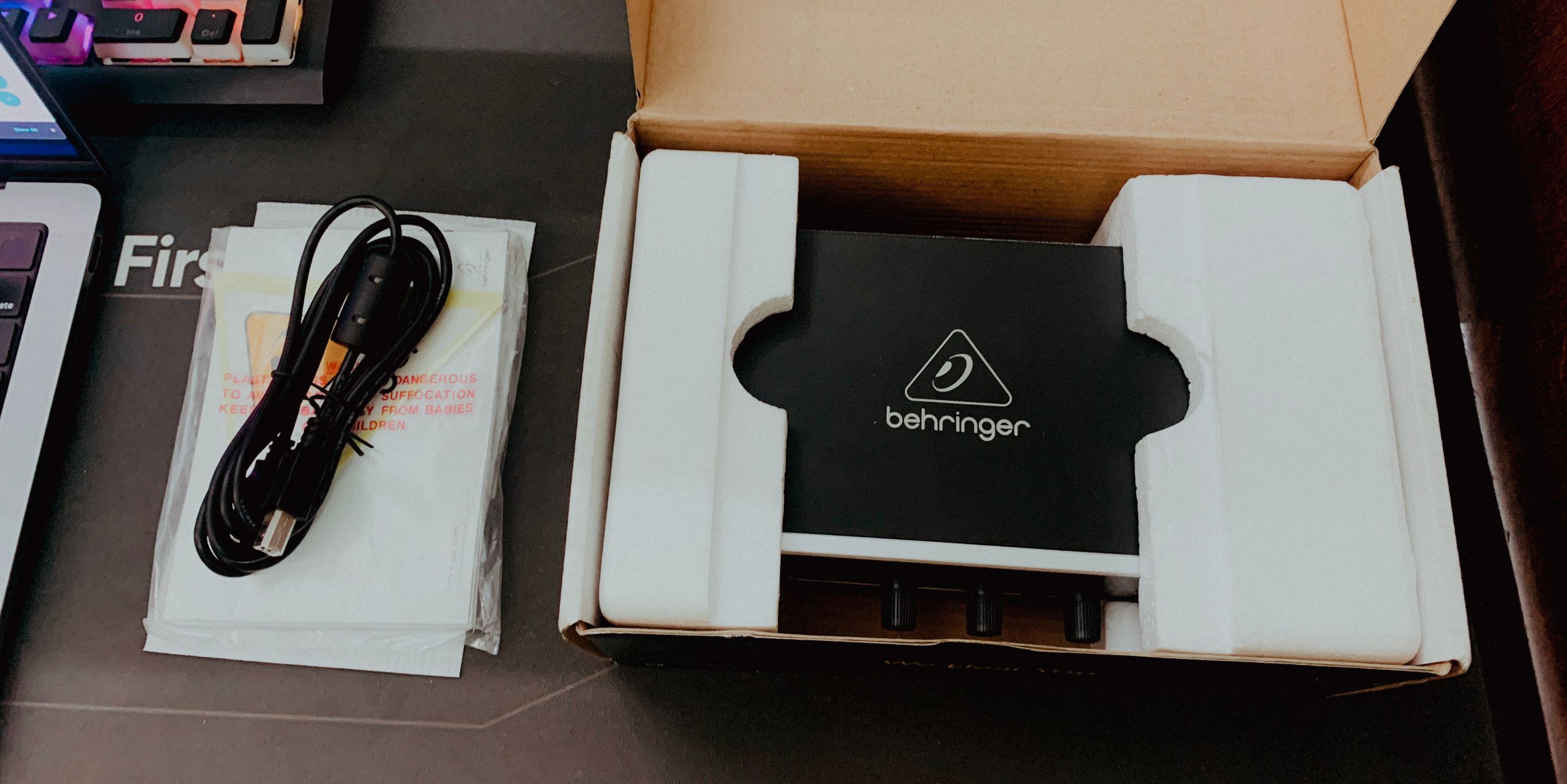 That's all you would need to have a functioning Audio card, as it's powered through the Hi-Fi USB cable; if you have an instrument or a condenser microphone, you can plug them from the front, and also, you would have microphone output as well. You would need an XLR cable for the microphone, and if you have a 3.5 mm audio jack in your headphone, you would need a 6.35mm to 3.5mm Audio Jack Adapter, and you are all set! Turn on Phantom power 48V if you have a condenser microphone. As you can see in the photo below, I am using the device in the same way. 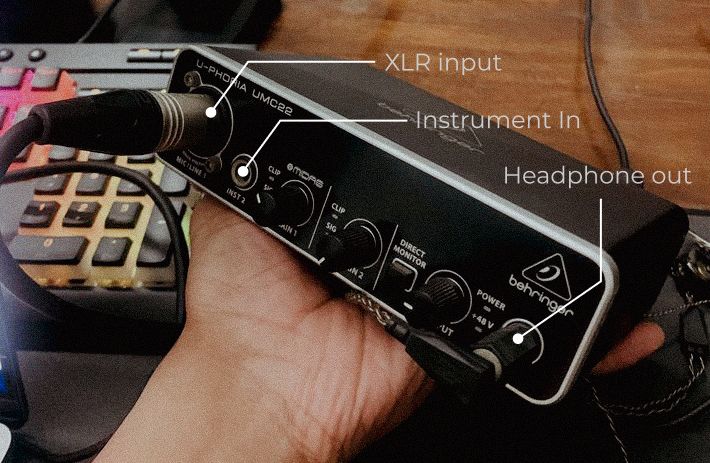 There are options for direct monitoring, which lets you hear whatever you are saying to the microphone without any delay. Midas(industry legend pre-amp) gain 1 for microphone gain control, Gain two dial lets you select gain for your instrument, and right beside headphone output, you have a volume control for your headphones+studio monitors. 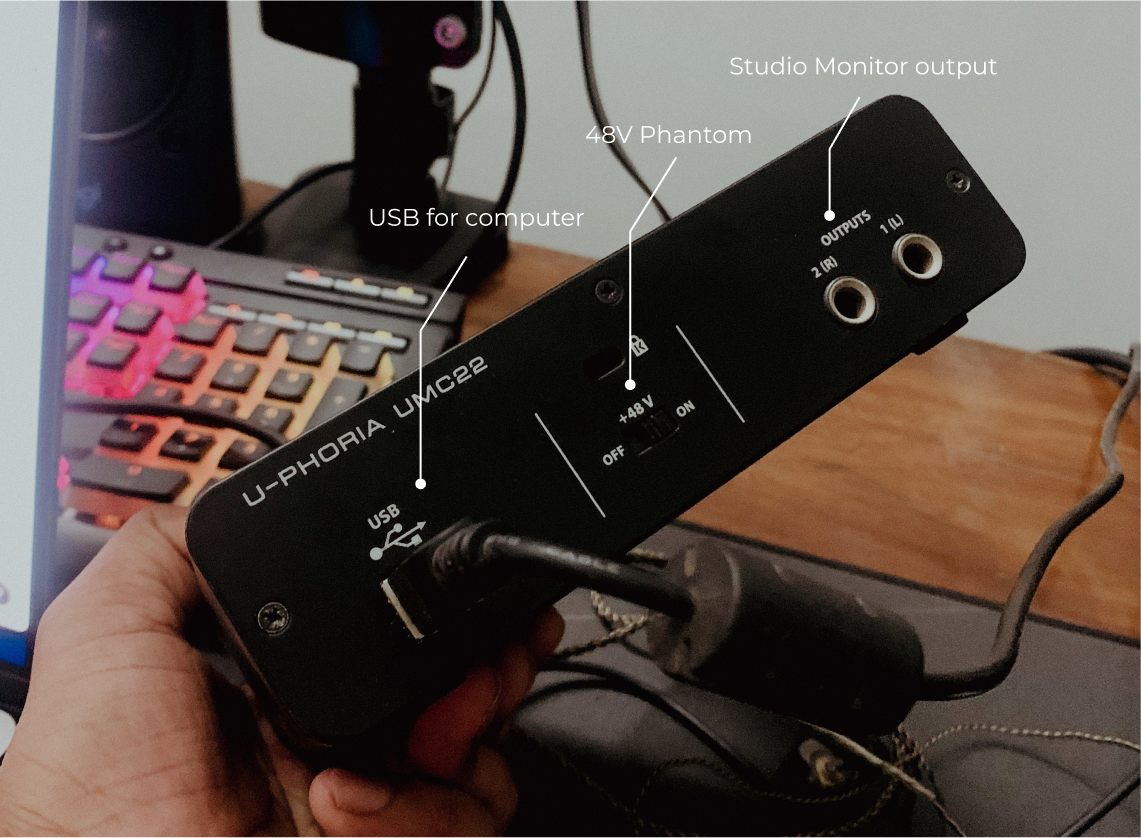 Right in the back, you can see the Hi-Fi USB connection for your device and switch to turn on +48V Phantom power which is crucial for a condenser microphone, and lastly, the two left and right outputs for studio monitors. ## How does it sound? Now, the exciting part, you can always use better equipment like an expensive condenser microphone and headphones to get better fidelity. But is that necessary? I have been using this interface with a Neewer NW-800 (a Chinese condenser microphone) and KZ ZSN PRO in-ear monitors. If you switch to this audio interface from a built-in sound card, you will notice the clarity in the sound system right away. I have received numerous appraisals from time to time on how my vocals are super crispy in discord chats, and the 48kHz audio output brings the best sound clarity to my headphones. I started noticing so many frequencies while listening to music that I had never experienced before. And if you want to be the JUDGE of how this Audio interface makes my vocal sound check out the cover songs that I'm linking below (haha, I know I am being sneaky here). This Behringer UMC22 audio interface has been my primary audio device for a long while, and it never disappointed me. <iframe width="2118" height="880" src="https://www.youtube.com/embed/3LGQj9aHnRM" title="YouTube video player" frameborder="0" allow="accelerometer; autoplay; clipboard-write; encrypted-media; gyroscope; picture-in-picture" allowfullscreen></iframe> <iframe width="100%" height="300" scrolling="no" frameborder="no" allow="autoplay" src="https://w.soundcloud.com/player/?url=https%3A//api.soundcloud.com/tracks/601576464&color=%23ff5500&auto_play=false&hide_related=false&show_comments=true&show_user=true&show_reposts=false&show_teaser=true&visual=true"></iframe><div style="font-size: 10px; color: #cccccc;line-break: anywhere;word-break: normal;overflow: hidden;white-space: nowrap;text-overflow: ellipsis; font-family: Interstate,Lucida Grande,Lucida Sans Unicode,Lucida Sans,Garuda,Verdana,Tahoma,sans-serif;font-weight: 100;"><a href="https://soundcloud.com/mahtabmashuq" title="Mahtab Mashuq" target="_blank" style="color: #cccccc; text-decoration: none;">Mahtab Mashuq</a> · <a href="https://soundcloud.com/mahtabmashuq/tanerelle-love-from-ngc-7318-cover-by-mahtab-mashuq-ft-c3ll-project" title="Tanerélle - Love from NGC 7318 Cover by Mahtab Mashuq ft. C3ll Project" target="_blank" style="color: #cccccc; text-decoration: none;">Tanerélle - Love from NGC 7318 Cover by Mahtab Mashuq ft. C3ll Project</a></div> ## Verdict This interface is the best entry-level Audio interface and can be a door for many people to experience the audiophile world. The best part is that I've recently upgraded to Audient Evo 4(that would be a discussion for another day). 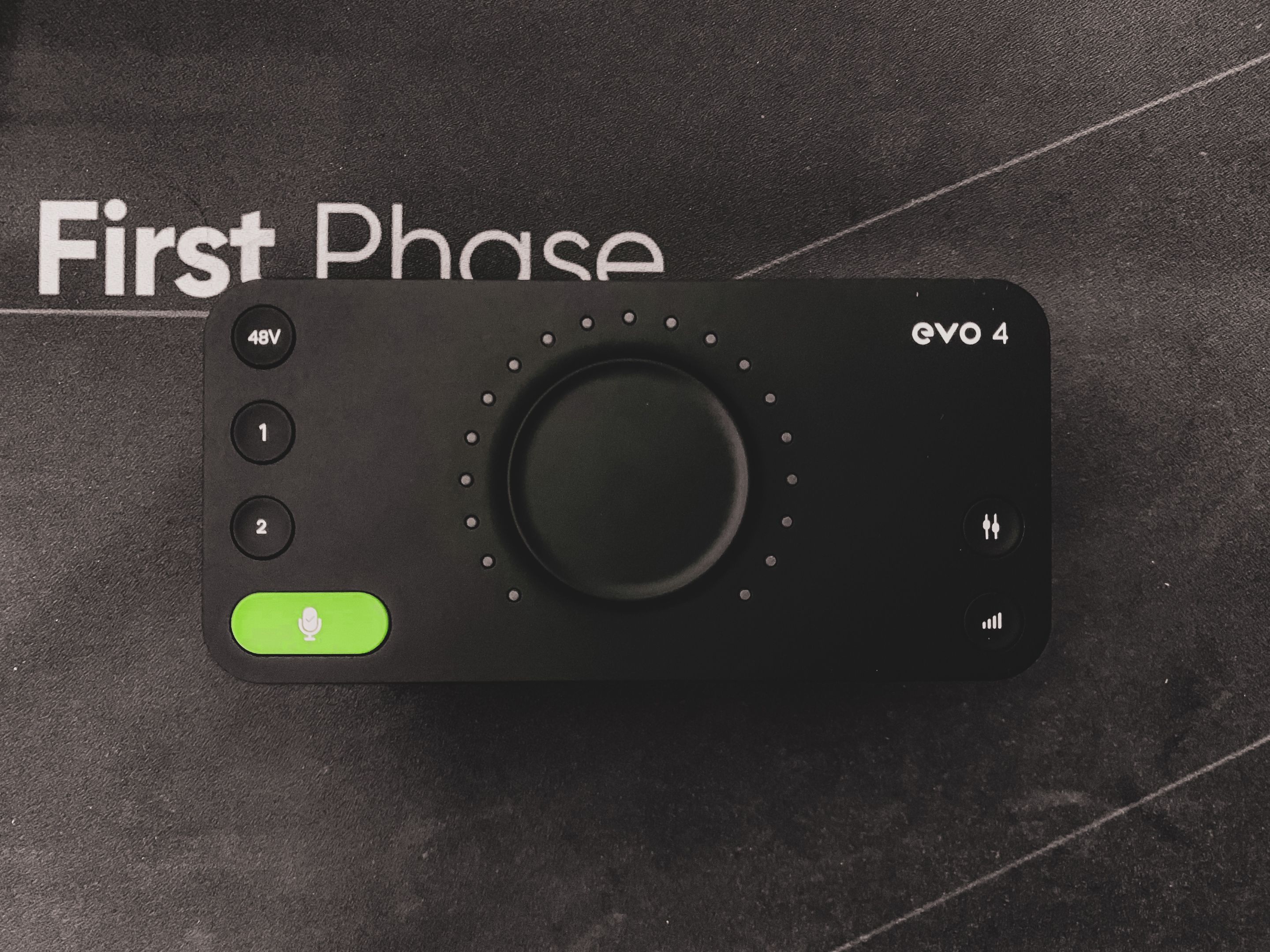<center> Audient Evo 4</center> **I am selling my UMC22 for 5000 BDT. All the photos are an example of the condition of the interface right now. Totally in mint condition. My location is Uttara.** I hope everyone stays dope till I get back. Thank you for the read; see you in the next post 👋🏻😊
👍 mariuszkarowski, curx, crokkon, apx, funnyman, eliel, codingdefined, stinawog, ernick, rakkasan84, jibspark, sustainablelivin, steem.services, ordinaryamerican, tinyvoter, optimizer, infinite-love, alphacore, ebargains, estream.studios, jacuzzi, xves, riazud, bergelmirsenpai, chrysanthemum, sakura21, surrealfia, yggdrasil.laguna, stemgeeks, abh12345.stem, brofund-stem, adamada.stem, solominer.stem, stemcuration, juecoree.stem, slider2990, cd-stem, stuntman.mike, dorkpower, stemcur, stemline, star.stem, babytarazkp, saboin.stem, scooter77.stem, riz611, juecoree, sillybilly, limka, fa-him, ukulima, chapmain, bdvoter.cur, mendezand, deepu7, bdvoter, shadonchandra, dogancankilment, drillith, zaku, hmetu, nonsowrites, iamjohn, tomlee, kgsupport, jessicaossom, temileke, hugo4u, xbdvoter, filler, rem-steem, reza-shamim, olaexcel, tcpaikano, prolinuxua, holovision.stem, krishu.stem, scholaris.stem,